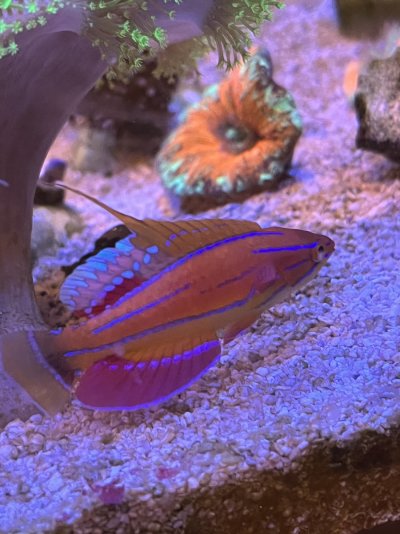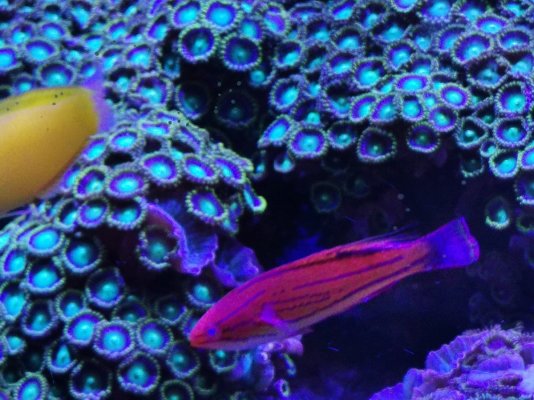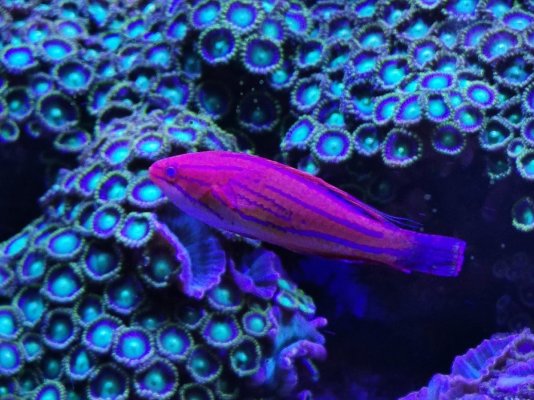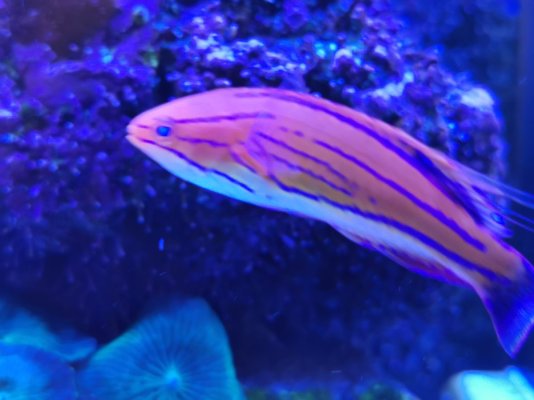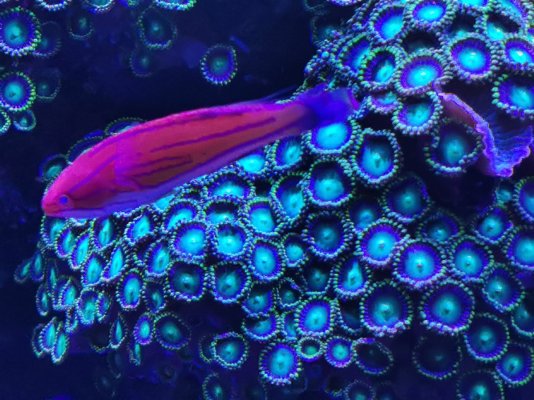SaltyT
Wrasse obsessed!
View Badges
Reef Squad
Excellence Award
Reef Tank 365
Photo of the Month
Article Contributor
Hospitality Award
Midwest Reefer
My Aquarium Showcase
As many of you know, the subject of wrasses is near and dear to my heart. I’ve noticed an uptick in questions regarding flasher wrasses lately so let’s talk about them!
First, let’s discuss the biology and behavior of these wrasses. Flasher wrasses and fairy wrasses are closely related and the two co-exist with each other throughout their geographic ranges. Flasher and fairy wrasses are both colorful, small and highly social. In the wild, they form large aggregations where females greatly outnumber males. Within these large aggregations are harems, where one dominant terminal-phase male spawns with a group of females. What do I mean by “terminal-phase” male? Glad you asked! In order to explain what that means, we need to dive a little deeper into their biology.

Paracheilinus attenuatus male flashing at a Cirrhilabrus johnsoni male. Photo by SaltyT
All flasher and fairy wrasses are protogynous hermaphrodites which means that they are all born as females and become secondary males through sex change brought on by social cues. After their post-larval stage, juvenile flasher and fairy wrasses begin to seek out their own kind and form groups. The juveniles within these groups develop into sexually mature females and begin exerting dominance over each other. The most dominant female will start her transformation into an initial-phase male. She will develop male sex organs and her appearance will begin to change. At this point it is possible for an initial-phase male to revert back to female if a more dominant male pressures him. Generally, this isn’t the case so as an initial-phase male grows and develops his characteristics will change, he’ll develop brighter coloration, larger finnage, and most importantly he’ll have the ability to flash. Once this happens, he is considered a terminal-phase male which means it is no longer possible for him to revert back to female.

Paracheilinus lineopunctatus in nuptial display. Photo by SaltyT
Now, let’s discuss what flasher wrasses are known for – flashing! Flashing is a term used to describe the nuptial display of a terminal-phase male. When he flashes, his colors enhance and metallic streaks and patches will display that aren’t visible when he’s in a relaxed state. During flashing episodes, he will erect his fins and swim with great speed to display at rival males or to attract the attention of females. Remember when I said that flasher and fairy wrasses co-exist with each other in large aggregations? Well, it just so happens that multiple species of flasher and fairy wrasses are usually found intermingling with each other and just to muddy things up even more, juveniles and females of multiple species are indistinguishable from each other. Even some juvenile and female fairy and flasher wrasses look similar to each other. How is a male supposed to pick out the correct species of female to spawn with in a group of intermixed species that look the same? The simple answer is he can’t, so that’s why mother nature gave him the ability to flash. When he flashes, he attracts the attention of a same-species female who identifies him instinctively as a male she can spawn with.

Paracheilinus nursalim male displaying for a harem of females in their natural habitat. Photo by Eric Cheng.
We’ve talked about their behavior and biology, now let’s discuss their habitat in the wild. Flasher wrasses are reef fish, but they’re rarely found among dense coral growths or in high surge reef areas. Instead, they prefer the outer edges of reefs and rubble flats where the reef is largely made up of relatively flat, unobstructed swimming areas. Low lying rubble enable males to swim freely at high rates of speed in order to put on their flashing displays at full effect.

Paracheilinus piscilineatus. Photo by Kevin Kohen.
So now let’s talk about keeping these beautiful fish! The most common questions I see asked are what size tank do they require? What other fish can I keep with them? Can I get a male and female? And how long do they live?
I’ll start with tank size. Flasher wrasses maybe small in stature, but they’re large when it comes to their activity level. Flasher wrasses are used to having ample room to zoom about at high speed without fear of running into anything. When we add them to our aquariums, they have to adjust to the confines of a glass box and the aquascape we’ve created. It’s not unusual for a flasher wrasse that’s been confined to small quarters to injury itself by hitting a lid or some other structure in our tanks. Their high activity level is why it’s highly recommended that flasher wrasses are kept in tanks no less than 4 feet in length and with a lid made of screen or mesh in order to lessen the chance that they injure themselves swimming into something.
Ideal tankmates for flasher wrasses are other peaceful community fish. I do recommend mixing males of different species in order to appreciate the stunning displays that they are known for.

Paracheilinus filamentosus males and females. Photo by Gerry Allen.
This brings me to the most frequently asked question; can I mix males and females? My advice is no because whether we like it or not, eventually all female Paracheilinus will transition to male in our closed systems regardless if a male is present or not. It’s nearly impossible to replicate the social hierarchy of a harem in our aquariums so without pressure on a female to spawn, nature will take its course and she will transition into a male. Two males of the same species will fight to the death in the confines of most of our tanks.
How long do flasher wrasses live? Sadly, flasher wrasses aren’t long lived so how long you get to enjoy them depends on the approximate age of the flasher wrasse when you acquire it. If you’re lucky enough to acquire a juvenile or female, you’ll see her transition into a gorgeous terminal-phase male and get to enjoy his displays for 4 to 5 years, possibly longer. Most of us acquire our flasher wrasses when they’re already a mature terminal-phase male so 3 to 4 years is a typical lifespan for males in our aquariums. Of course, your wrasse may live longer or less depending on how old he or she was when they were collected.

Paracheilinus mccoskeri. Photo by LiveAquaria.
Flasher wrasses are easy to keep and can make a wonderful addition to your tank as long as some basic requirements are met. Give them ample room to zoom about at the high speeds they’re known for and keep a mesh or screen lid on the tank so they don’t jump out or injure themselves. They’re not picky eaters and will eat just about anything you offer them. Most species are readily available and fairly inexpensive. I hope you enjoyed reading about these flashy little wrasses. Until next time, happy reefing!
First, let’s discuss the biology and behavior of these wrasses. Flasher wrasses and fairy wrasses are closely related and the two co-exist with each other throughout their geographic ranges. Flasher and fairy wrasses are both colorful, small and highly social. In the wild, they form large aggregations where females greatly outnumber males. Within these large aggregations are harems, where one dominant terminal-phase male spawns with a group of females. What do I mean by “terminal-phase” male? Glad you asked! In order to explain what that means, we need to dive a little deeper into their biology.
Paracheilinus attenuatus male flashing at a Cirrhilabrus johnsoni male. Photo by SaltyT
All flasher and fairy wrasses are protogynous hermaphrodites which means that they are all born as females and become secondary males through sex change brought on by social cues. After their post-larval stage, juvenile flasher and fairy wrasses begin to seek out their own kind and form groups. The juveniles within these groups develop into sexually mature females and begin exerting dominance over each other. The most dominant female will start her transformation into an initial-phase male. She will develop male sex organs and her appearance will begin to change. At this point it is possible for an initial-phase male to revert back to female if a more dominant male pressures him. Generally, this isn’t the case so as an initial-phase male grows and develops his characteristics will change, he’ll develop brighter coloration, larger finnage, and most importantly he’ll have the ability to flash. Once this happens, he is considered a terminal-phase male which means it is no longer possible for him to revert back to female.
Paracheilinus lineopunctatus in nuptial display. Photo by SaltyT
Now, let’s discuss what flasher wrasses are known for – flashing! Flashing is a term used to describe the nuptial display of a terminal-phase male. When he flashes, his colors enhance and metallic streaks and patches will display that aren’t visible when he’s in a relaxed state. During flashing episodes, he will erect his fins and swim with great speed to display at rival males or to attract the attention of females. Remember when I said that flasher and fairy wrasses co-exist with each other in large aggregations? Well, it just so happens that multiple species of flasher and fairy wrasses are usually found intermingling with each other and just to muddy things up even more, juveniles and females of multiple species are indistinguishable from each other. Even some juvenile and female fairy and flasher wrasses look similar to each other. How is a male supposed to pick out the correct species of female to spawn with in a group of intermixed species that look the same? The simple answer is he can’t, so that’s why mother nature gave him the ability to flash. When he flashes, he attracts the attention of a same-species female who identifies him instinctively as a male she can spawn with.
Paracheilinus nursalim male displaying for a harem of females in their natural habitat. Photo by Eric Cheng.
We’ve talked about their behavior and biology, now let’s discuss their habitat in the wild. Flasher wrasses are reef fish, but they’re rarely found among dense coral growths or in high surge reef areas. Instead, they prefer the outer edges of reefs and rubble flats where the reef is largely made up of relatively flat, unobstructed swimming areas. Low lying rubble enable males to swim freely at high rates of speed in order to put on their flashing displays at full effect.
Paracheilinus piscilineatus. Photo by Kevin Kohen.
So now let’s talk about keeping these beautiful fish! The most common questions I see asked are what size tank do they require? What other fish can I keep with them? Can I get a male and female? And how long do they live?
I’ll start with tank size. Flasher wrasses maybe small in stature, but they’re large when it comes to their activity level. Flasher wrasses are used to having ample room to zoom about at high speed without fear of running into anything. When we add them to our aquariums, they have to adjust to the confines of a glass box and the aquascape we’ve created. It’s not unusual for a flasher wrasse that’s been confined to small quarters to injury itself by hitting a lid or some other structure in our tanks. Their high activity level is why it’s highly recommended that flasher wrasses are kept in tanks no less than 4 feet in length and with a lid made of screen or mesh in order to lessen the chance that they injure themselves swimming into something.
Ideal tankmates for flasher wrasses are other peaceful community fish. I do recommend mixing males of different species in order to appreciate the stunning displays that they are known for.
Paracheilinus filamentosus males and females. Photo by Gerry Allen.
This brings me to the most frequently asked question; can I mix males and females? My advice is no because whether we like it or not, eventually all female Paracheilinus will transition to male in our closed systems regardless if a male is present or not. It’s nearly impossible to replicate the social hierarchy of a harem in our aquariums so without pressure on a female to spawn, nature will take its course and she will transition into a male. Two males of the same species will fight to the death in the confines of most of our tanks.
How long do flasher wrasses live? Sadly, flasher wrasses aren’t long lived so how long you get to enjoy them depends on the approximate age of the flasher wrasse when you acquire it. If you’re lucky enough to acquire a juvenile or female, you’ll see her transition into a gorgeous terminal-phase male and get to enjoy his displays for 4 to 5 years, possibly longer. Most of us acquire our flasher wrasses when they’re already a mature terminal-phase male so 3 to 4 years is a typical lifespan for males in our aquariums. Of course, your wrasse may live longer or less depending on how old he or she was when they were collected.
Paracheilinus mccoskeri. Photo by LiveAquaria.
Flasher wrasses are easy to keep and can make a wonderful addition to your tank as long as some basic requirements are met. Give them ample room to zoom about at the high speeds they’re known for and keep a mesh or screen lid on the tank so they don’t jump out or injure themselves. They’re not picky eaters and will eat just about anything you offer them. Most species are readily available and fairly inexpensive. I hope you enjoyed reading about these flashy little wrasses. Until next time, happy reefing!
Last edited:




